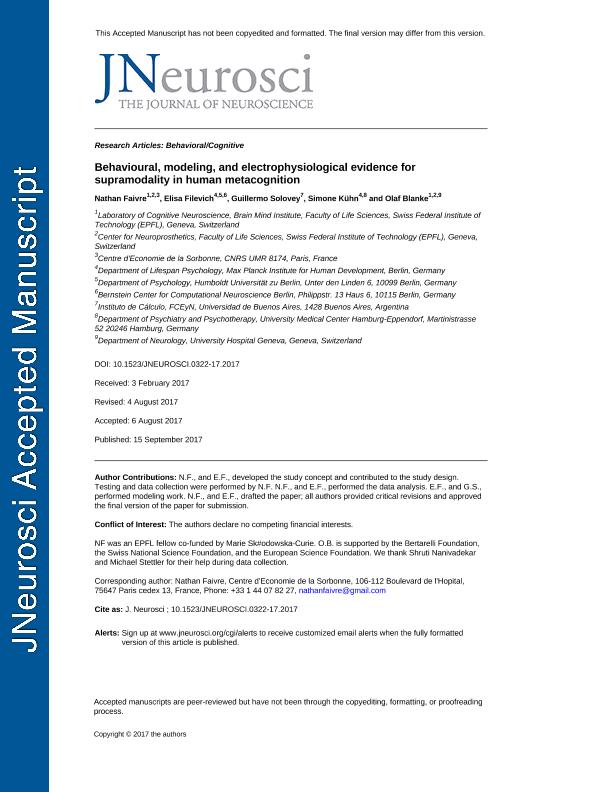Mostrar el registro sencillo del ítem
dc.contributor.author
Faivre, Nathan
dc.contributor.author
Filevich, Elisa
dc.contributor.author
Solovey, Guillermo

dc.contributor.author
Kühn, Simone
dc.contributor.author
Blanke, Olaf
dc.date.available
2018-09-19T18:24:17Z
dc.date.issued
2018-01
dc.identifier.citation
Faivre, Nathan; Filevich, Elisa; Solovey, Guillermo; Kühn, Simone; Blanke, Olaf; Behavioral, modeling, and electrophysiological evidence for supramodality in human metacognition; Society for Neuroscience; Journal of Neuroscience; 38; 2; 1-2018; 263-277
dc.identifier.issn
0270-6474
dc.identifier.uri
http://hdl.handle.net/11336/60265
dc.description.abstract
Human metacognition, or the capacity to introspect on one’s own mental states, has been mostly characterized through confidence reports in visual tasks. A pressing question is to what extent results from visual studies generalize to other domains. Answering this question allows determining whether metacognition operates through shared, supramodal mechanisms or through idiosyncratic, modality-specific mechanisms. Here, we report three new lines of evidence for decisional and postdecisional mechanisms arguing for the supramodality of metacognition. First, metacognitive efficiency correlated among auditory, tactile, visual, and audiovisual tasks. Second, confidence in an audiovisual task was best modeled using supramodal formats based on integrated representations of auditory and visual signals. Third, confidence in correct responses involved similar electrophysiological markers for visual and audiovisual tasks that are associated with motor preparation preceding the perceptual judgment. We conclude that the supramodality of metacognition relies on supramodal confidence estimates and decisional signals that are shared across sensory modalities.
dc.format
application/pdf
dc.language.iso
eng
dc.publisher
Society for Neuroscience

dc.rights
info:eu-repo/semantics/openAccess
dc.rights.uri
https://creativecommons.org/licenses/by-nc-sa/2.5/ar/
dc.subject
Audiovisual
dc.subject
Confidence
dc.subject
Eeg
dc.subject
Metacognition
dc.subject
Signal Detection Theory
dc.subject
Supramodality
dc.subject.classification
Bioquímica y Biología Molecular

dc.subject.classification
Ciencias Biológicas

dc.subject.classification
CIENCIAS NATURALES Y EXACTAS

dc.title
Behavioral, modeling, and electrophysiological evidence for supramodality in human metacognition
dc.type
info:eu-repo/semantics/article
dc.type
info:ar-repo/semantics/artículo
dc.type
info:eu-repo/semantics/publishedVersion
dc.date.updated
2018-09-17T19:30:11Z
dc.journal.volume
38
dc.journal.number
2
dc.journal.pagination
263-277
dc.journal.pais
Estados Unidos

dc.journal.ciudad
Washington
dc.description.fil
Fil: Faivre, Nathan. Swiss Federal Institute of Technology Zurich; Suiza. Centre National de la Recherche Scientifique; Francia
dc.description.fil
Fil: Filevich, Elisa. Max Planck Institute for Human Development; Alemania. Humboldt Universität zu Berlin; Alemania. Bernstein Center for Computational Neuroscience Berlin; Alemania
dc.description.fil
Fil: Solovey, Guillermo. Consejo Nacional de Investigaciones Científicas y Técnicas; Argentina. Universidad de Buenos Aires. Facultad de Ciencias Exactas y Naturales. Instituto de Cálculo; Argentina
dc.description.fil
Fil: Kühn, Simone. Max Planck Institute for Human Development; Alemania. University Medical Center Hamburg-Eppendorf; Alemania
dc.description.fil
Fil: Blanke, Olaf. Swiss Federal Institute of Technology Zurich; Suiza. Universidad de Ginebra; Suiza
dc.journal.title
Journal of Neuroscience

dc.relation.alternativeid
info:eu-repo/semantics/altIdentifier/doi/https://dx.doi.org/10.1523/JNEUROSCI.0322-17.2017
dc.relation.alternativeid
info:eu-repo/semantics/altIdentifier/url/http://www.jneurosci.org/content/38/2/263
Archivos asociados
